
We’re here to help! Wild Yards is a completely free website that is 100% dedicated to helping you create a wildlife-friendly, sustainable yard. Read more
WildYards is reader-supported. When you buy a product through a link on our site, we may earn a comission. Every product is independently selected by our (obsessive) editors and our reviews are unbiased and objective. Read more about our mission or our privacy policy.
Mushrooms are a favorite amongst backyard foragers. They’re the perfect addition to many dishes, from soups and salads to casseroles and side dishes.
But not all mushrooms are edible. Some mushrooms can be deadly if consumed.
If you walked out onto your lawn recently and found a bunch of orange mushrooms in your yard, you’re probably wondering what kinds of mushrooms they are, and whether or not they’re safe to eat.
Knowing which mushrooms are edible and which are toxic will help you decide if you need to eliminate the fungi.
So, which types of orange mushrooms are most likely to pop up in your garden, and what should you do about them?
Wax caps, Jack o’lanterns, and orange peel mushrooms are most commonly found in residential areas. Unless you’re an expert at identifying different types of mushrooms, we advise against harvesting these mushrooms to eat. Toxic mushrooms should be removed to keep kids and pets safe.
Why are there orange mushrooms growing on your lawn?
Before we get down to the business of identifying the orange mushrooms growing in your yard, you’d probably like to know just why they’re growing there in the first place.
Once the fruiting body of a mushroom is ripe, it releases tiny spores which spread easily in the wind. These microscopic “seeds” land in the soil where they can remain dormant for years until ideal conditions arrive.
Mushrooms rely on several factors to germinate. Most mushrooms grow best in moist soils and in humid climates. Many mushrooms also grow best during the warmer months, so the season can affect mushroom germination as well.
When conditions are ideal, the mushroom spore starts taking shape. Spores begin producing hyphae, filaments that wrap around the roots of surrounding plants.
As the hyphae grow, they produce a mycelium, which is an intricate web-like mass of hyphae.
The hyphae feed off of plant sugars. But because they also increase water and nutrient availability to the plants, they have a symbiotic relationship with plants, rather than a parasitic one.
Once the mycelium has matured, it can reproduce. The mycelium begins forming a fruiting body, what we know as mushrooms.
Mushrooms develop above ground where they ripen. As the mushrooms die, they release their spores, which can be carried away to new locations to begin the process all over again.
Most fungi grow best in moist, shady locations and in fertile soils rich in decaying organic matter. So if you’re finding lots of mushrooms growing in your yard, take that as a sign that your soil is in great shape.
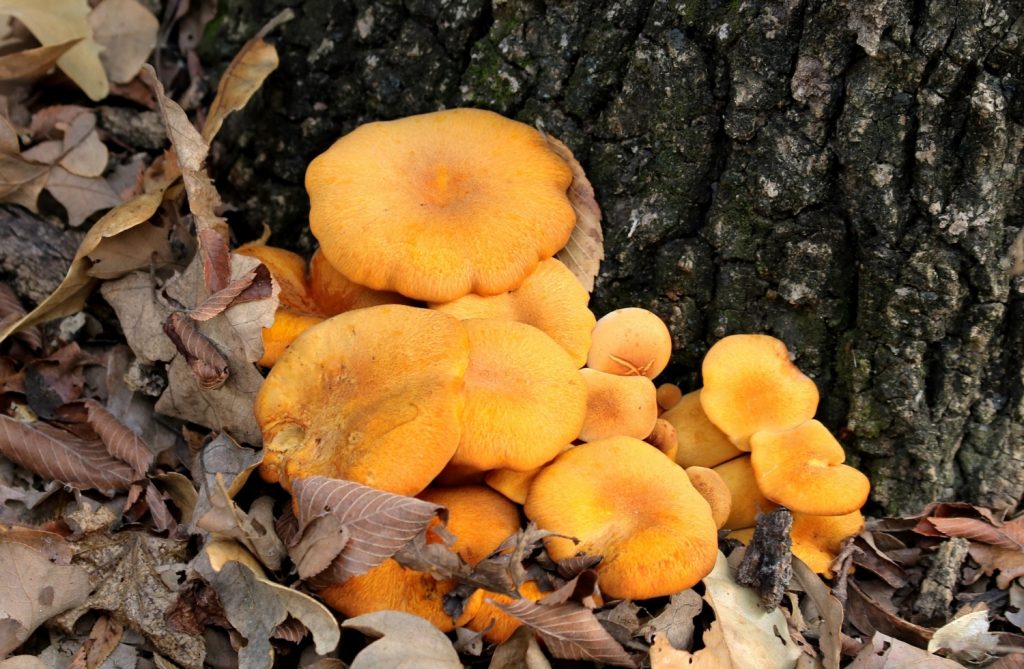
14 Types of orange mushrooms commonly found in yards
Not all orange mushrooms are the same. Some have flat caps and others have bell-shaped ones. Some are shiny and smooth while others are bumpy and leathery.
Knowing how to tell orange mushrooms apart is essential. This will help you determine whether these mushrooms can be left alone or are toxic toadstools that should be removed.
Take a look at these 14 types of orange mushrooms that can be found in yards. Which ones have you spotted in your garden?
Orange peel fungus (Aleuria aurantia)
Also known as orange fairy cup mushrooms, the orange peel fungus looks a lot like its namesake. These mushrooms do not have stems but instead resemble rounds of orange peel that have been discarded on the ground.
Orange peel mushrooms are bright orange, with crinkled edges that turn upwards. The tops of these mushrooms are relatively smooth, but the undersides are fuzzy.
You can find orange peel mushrooms growing in grassy areas where the soil is regularly disturbed. You may see orange peel mushrooms growing along trails and walking paths, or in garden beds that haven’t yet been planted.
These types of mushrooms are relatively small, but thanks to their vivid coloring, they’re easy to find. Fruiting bodies measure between 0.6” to 2.7”.
The orange peel mushroom is non-toxic and quite edible, though it doesn’t have much taste. It’s worth noting that the orange peel mushroom resembles some species of Otidea fungi, which are poisonous.
Avoid harvesting orange peel mushrooms for consumption without professional guidance to help you distinguish between these two species.
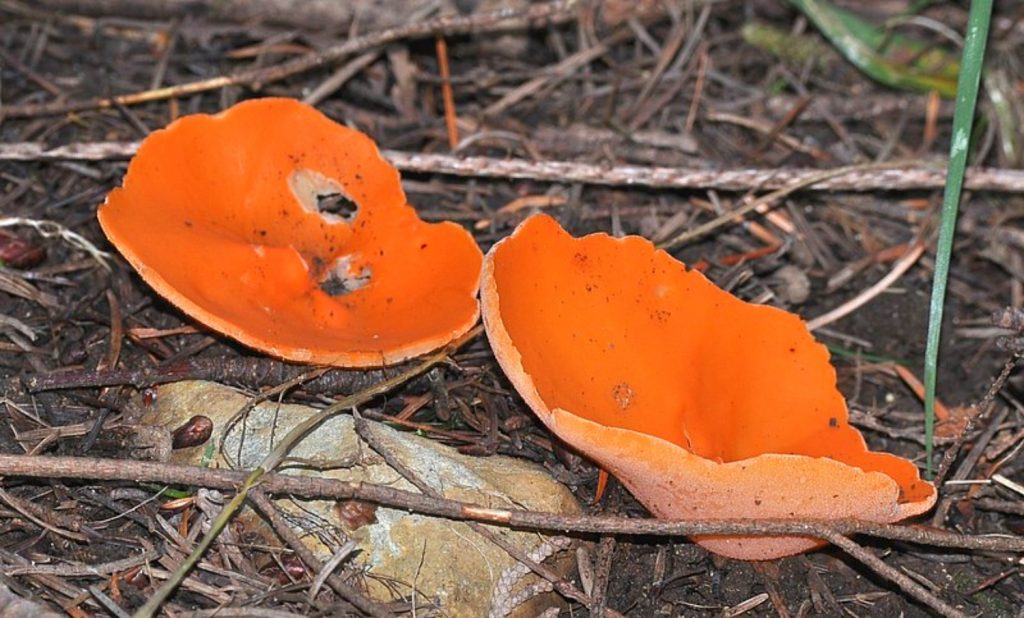
Lobster mushroom (Hypomyces lactifluorum)
The lobster mushroom is not a real mushroom. Rather, it is a type of parasitic fungus that invades certain mushroom species.
Mushrooms that have been infected with lobster fungus turn bright reddish-orange and develop a tough, wavy outer skin similar in shape and color to a lobster tail. The flesh may be covered in tiny white bumps.
Lobster mushrooms are edible, and ironically enough, are beloved for their seafood-like taste. This mushroom’s dense, meaty texture makes it a great addition to hearty meals.
Naturally, you can also use lobster mushrooms to add some color and flavor to your favorite seafood dishes.
Because lobster fungi primarily parasitize mushrooms from the Lactarius and Russula genera, you can find lobster mushrooms where these two types of mushrooms prefer to grow.
Look for lobster mushrooms in wooded areas, particularly on riverbanks and near marshes and streams. This fungus grows best in moist, shady areas.
Golden trumpet (Xeromphalina campanella)
If you’ve ever gone hiking, you’ve probably seen the muted orange-brown golden trumpet mushroom growing on rotting wood.
Golden trumpets are small mushrooms with button caps that look like umbrellas turned inside out as they age.
These types of mushrooms don’t get very big. They typically measure between 0.5” to 1” in length and can be found growing in clusters on rotting logs and decaying wood.
Look for golden trumpet mushrooms in wooded areas, especially conifer woodlands. These mushrooms thrive in moist, shady spots, and are a common fixture on dead trees and decaying stumps.
Golden trumpet mushrooms are not toxic. However, they are bitter tasting and not very pleasant to eat.
They pose no threat to children or pets, so there’s no need to remove them from your lawn. But there’s no point in gathering them to use in your kitchen, either.
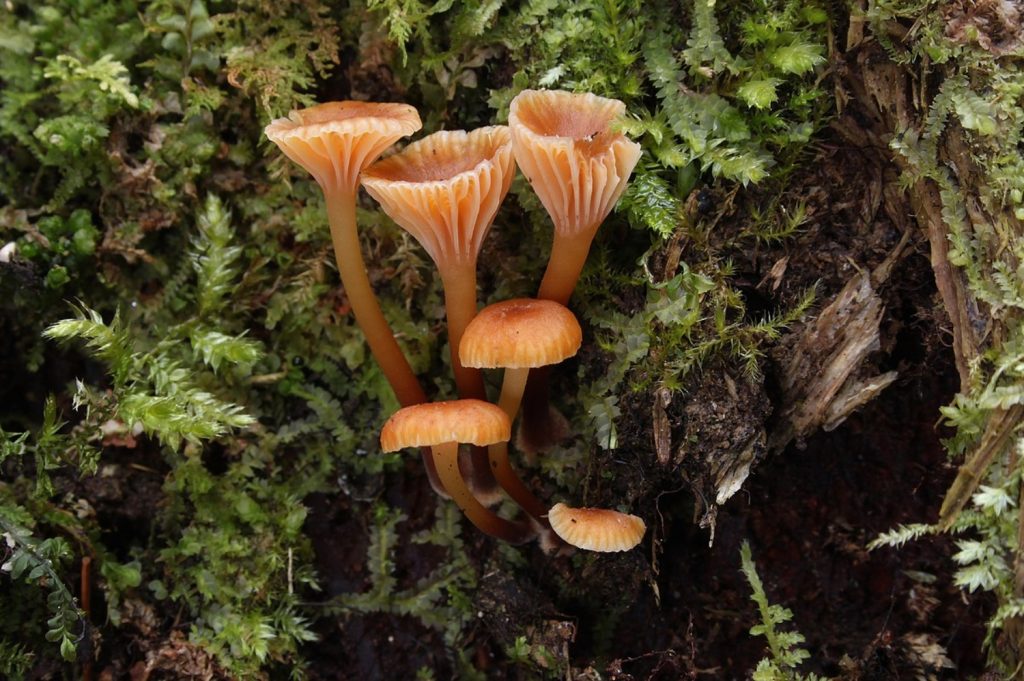
Orange mycena (Mycena leaiana)
Orange mycena is not known to be edible. These mushrooms are small in size, measuring 0.3” to 1.5” on average, and they have a sticky, rubbery texture that isn’t exactly appealing. So they typically aren’t harvested.
That said, the orange mycena is not known to be toxic either so there’s no need to go ripping every orange mycena you find out of your yard.
These mushrooms are delightful to look at, with bright orange caps and creamy gills creating an interesting contrast. The bell-shaped caps are situated at the tips of long, spindly stems giving these mushrooms an otherworldly appearance.
They’d look just right in your miniature fairy garden.
Like most other mushrooms, orange mycena grows best in shady, moist areas. These fungi are often found on rotting stumps and decaying logs, especially in hardwood forests.
Orange mycena mushrooms help break down decomposing materials, making them more usable for surrounding trees and shrubs. Like the yellow mold found in some moist soils, these mushrooms help make the substrate rich, loamy, and fertile.
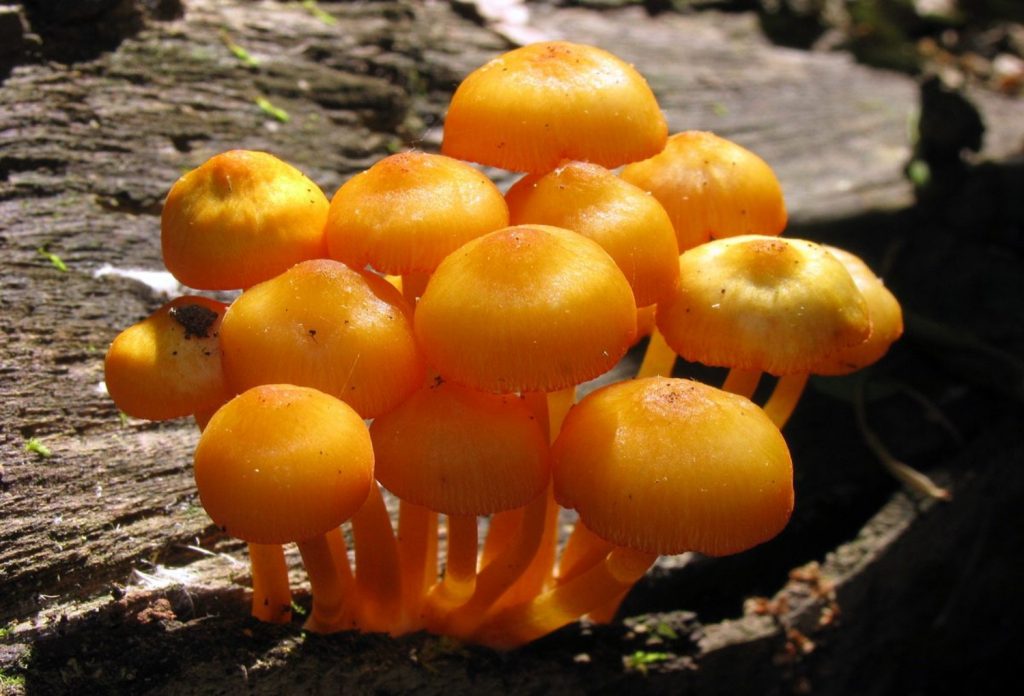
Bradleys mushroom (Lactarius volemus)
When the Bradleys mushroom first emerges, it looks a lot like a small potato. But as it grows, it develops a thick, sturdy stem and a rust-orange, meaty cap.
When plucked, these solitary mushrooms produce a milky white sap. The flesh turns brown over time as the mushroom ages, whether it’s been harvested or not.
Bradleys mushrooms are edible and are a great option for foragers. Their somewhat large size (these mushrooms measure 2” to 4” tall on average) and mild flavor make them well worth eating.
Orange fly agaric (Amanita muscaria var. guessowii)
Highly toxic, the orange fly agaric has sturdy white stems and bright orange caps dappled with white raised spots.
Caps start out umbrella-shaped, and gradually flatten out as the mushroom matures. These are sizeable mushrooms with fruiting bodies measuring 2.7” to 7”.
These types of mushrooms are often found near birch and pine trees. They have a penchant for coniferous woodlands but can be found in deciduous forests as well.
These are attractive mushrooms with an eye-catching appearance. They’re also easy to identify.
But because they’re deadly, it goes without saying that it’s best to remove them if you have kids or pets who like to put things in their mouths.
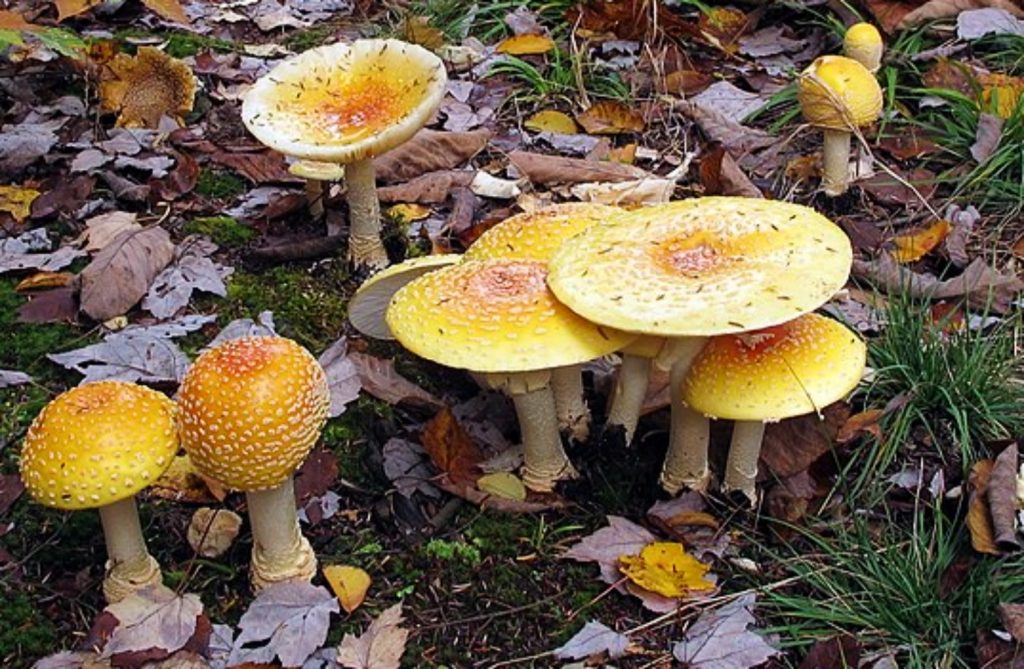
Cinnabar chanterelles (Cantharellus cinnabarinus)
Bright orange to muted red, cinnabar chanterelles grows in hardwood and coniferous forests, where they break down decaying matter, returning valuable nutrients to the soil.
Although the cinnabar mushroom doesn’t have much flavor to speak of, it does have tremendous health benefits thanks to a substance called canthaxanthin.
This compound is what gives the cinnabar mushroom its lovely orange color, and it also displays potent antioxidant activity, making this mushroom a superfood.
Cinnabar mushrooms can be found throughout the warm summer months. These mushrooms are significantly smaller than traditional chanterelles, measuring just 0.4” to 1.6” inches tall.
These mushrooms have a vase or trumpet shape, and uniform coloring that only lightens slightly along the edges and at the gills. Cinnabar chanterelles often grow in clusters of 2 to 3.
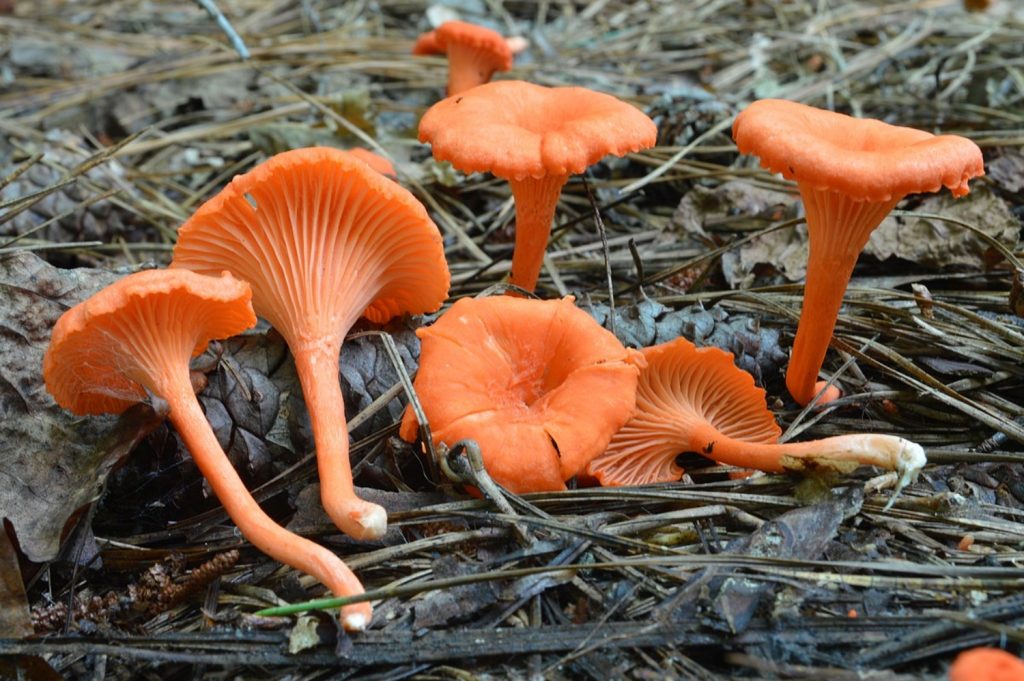
Jack-o’lantern mushroom (Omphalotus illudens)
Often mistaken for a chanterelle, Jack o’lantern mushrooms are toxic, which just goes to show you the importance of properly identifying a mushroom before consuming it!
Jack o’lantern mushrooms have thick stalks which are paler than their bright orange caps. The caps themselves are quite rounded initially, a traditional umbrella shape. But, as the mushroom ripens, the cap turns upward and develops a vase shape.
Jack o’lantern mushrooms aren’t sticky or shiny. Their caps are velvety and smooth, which can help you distinguish them from other orange mushrooms.
You’ll often find Jack o’lantern mushrooms growing in damp, shady locations. They favor rotting wood and decaying stumps.
These mushrooms are quite sizeable compared to some of the others mentioned here. Jack o’lantern mushrooms measure anywhere from 1.3” to 3.5”. Interestingly, they also glow in the dark, lighting up the night with a blue-green bioluminescent glow.
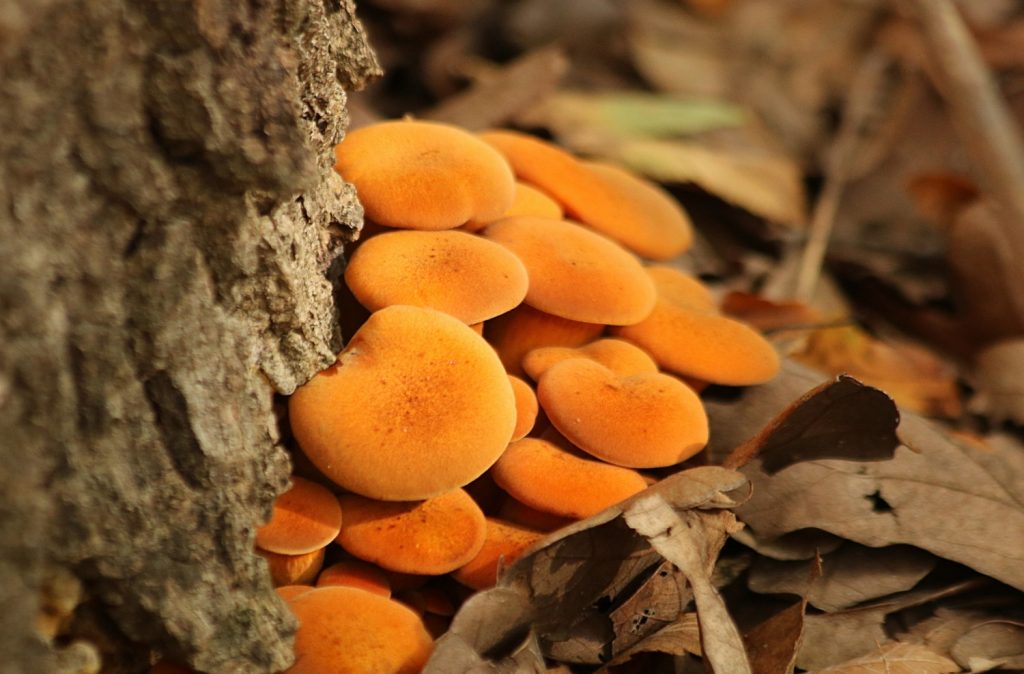
Chicken of the woods mushroom (Laetiporus sulphureus)
Also known as crab of the woods and sulphur shelf, chicken of the woods mushrooms are parasitic shelf fungi that typically grow at the base of living trees.
Chicken of the woods mushrooms are pretty easy to spot. These fungi produce wavy fruiting bodies that are bright orange to red at the center and fade to yellow along the periphery.
This type of fungus prefers to grow on oak trees, so it’s most commonly found in shady hardwood forests.
Chicken of the woods can range in size from 2” to 10”. This is a large fungus that’s almost impossible to miss!
Backyard foragers enjoy harvesting chicken of the woods mushrooms, as they are not only edible but delectable.
This fungus is also an excellent mushroom for beginner foragers because it has no real lookalikes. Thanks to its dense texture, chicken of the woods can be used in place of meat and added to your favorite sauteed veggie dishes.
Conical waxy cap (Hygrocybe conica)
Small, sticky mushrooms with orange-red caps and yellow stems, conical waxy caps have cone-shaped caps and a waxy texture — so they’ve been aptly named.
You’re most likely to find conical waxy caps growing in hardwood forests. These little mushrooms measure around 0.5” to 1.5” and thrive in the litter of the forest floor.
Also called witch’s hat, like other waxy caps, the conical waxy cap is not known to be toxic. That said, this mushroom’s minute size and less-than-appetizing texture render it inedible.
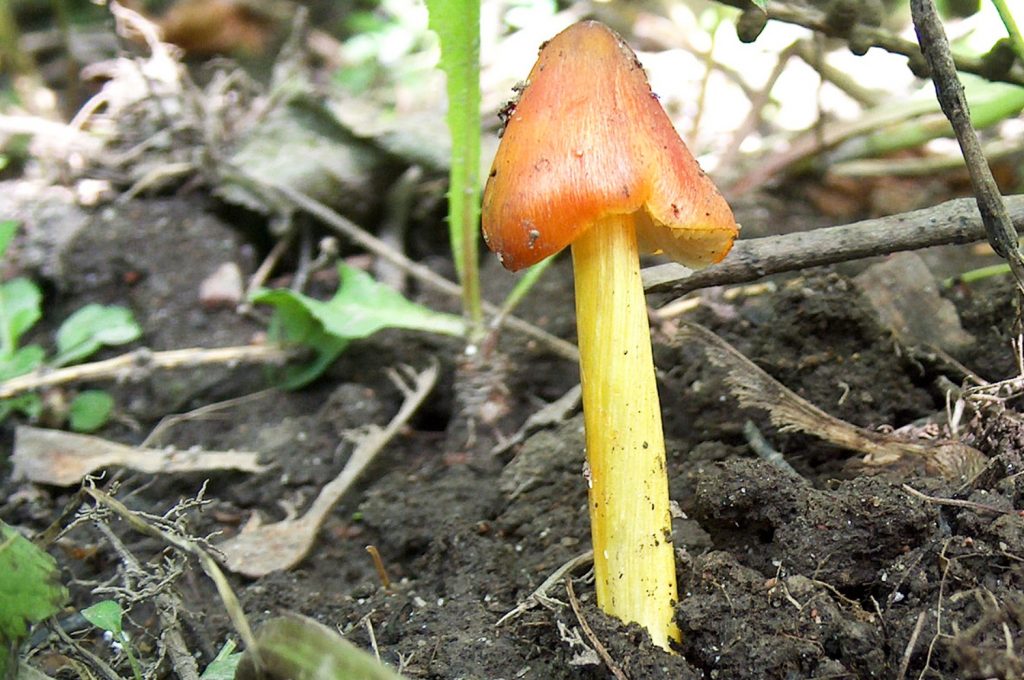
Orange bonnet (Mycena acicula)
Orange bonnet mushrooms are so small that they are considered to be inedible. Therefore, it’s not clear whether they’re toxic or not.
These dainty mushrooms measure 0.5” to 2.4” in length, and are most often found growing in moist deciduous forests.
The orange bonnet is a colorful mushroom, appearing in various shades of tan, orange, and yellow. These fungi have long, winding stems and rounded, bell-shaped caps that become more pointed as they mature.
If you peek beneath the caps, you’ll find bright orange gills outlined by vivid red margins. These sticky, slimy mushrooms grow in clusters.
Overall, orange bonnets are benign little mushrooms that help the plants in your backyard absorb more nutrients. These fungi are fun to watch as they mature.
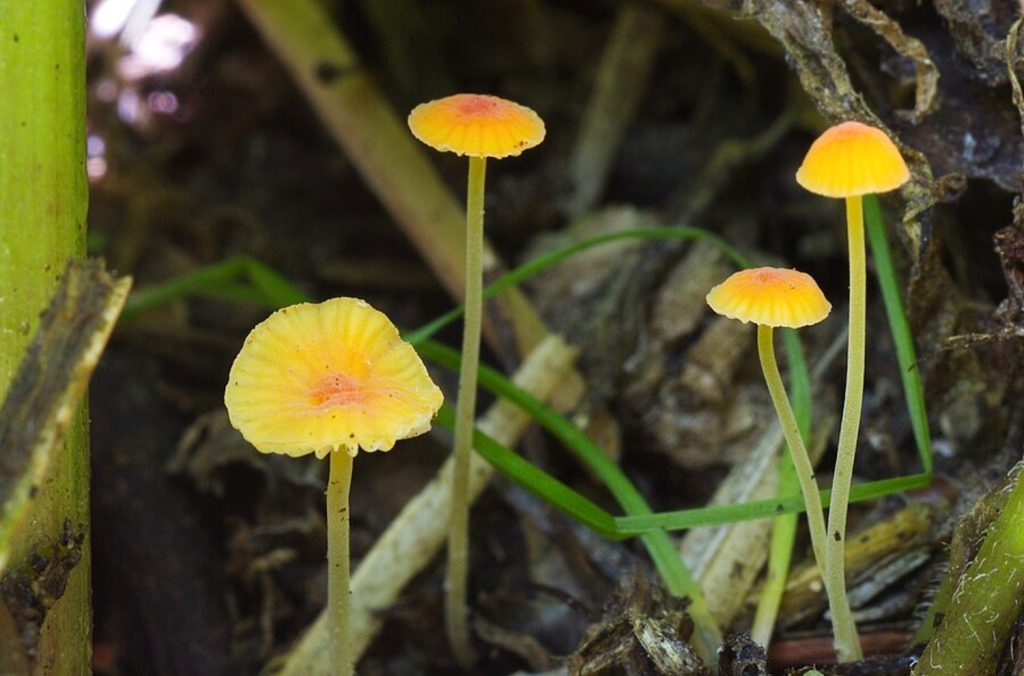
Jackson’s slender amanita (Amanita jacksonii)
When Jackson’s slender amanita mushrooms emerge, their orange-brown caps are shiny, smooth, and egg-shaped.
But as they ripen, their caps begin to open, slowly becoming flat and turning upward at the edges.
Jackson’s slender amanita is somewhat easy to identify. These mushrooms have bright orange caps and paler stems that retain a small white bulb at the base, even when picked. Fruiting bodies measure up to 4” tall.
Although Jackson’s slender amanita is a member of the Amanitaceae family, which contains some of the most deadly mushrooms in the world, Jackson’s slender amanita is not known to be toxic itself.
Still, because this mushroom resembles some toadstools, it’s best to avoid harvesting Jackson’s slender amanita unless you’re 100% sure that’s what you’ve harvested.
Red pine mushroom (Lactarius deliciosus)
Unsurprisingly, these short, stubby mushrooms are a common fixture in piney woods, growing in the moist, shady litter of coniferous forests.
Red pine mushrooms are usually anywhere from 1” to 3” tall, with stout stems and dense vase-shaped caps that are vibrant carrot-orange in color.
These mushrooms secrete pale red milk, or latex, when cut, and feel sticky to the touch. After handling, red pine mushrooms develop green stains.
In spite of their slightly slimy texture, red pine mushrooms are considered a delicacy.
These mushrooms are delicious when eaten raw, but can also be added to stir-fries to give your veggies some extra flavor.
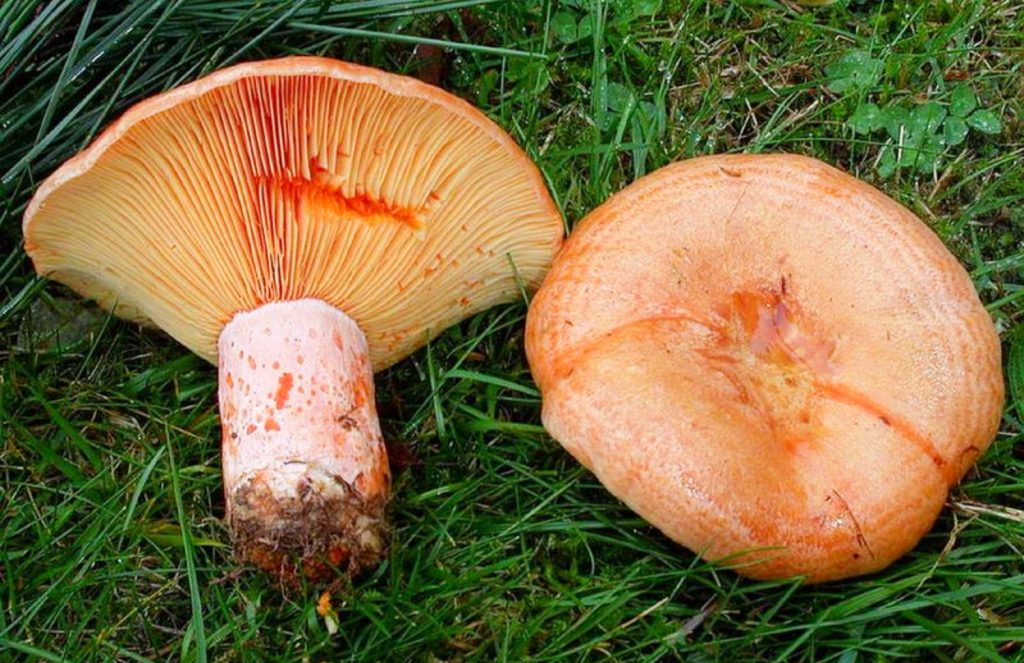
Goblet waxcap mushroom (Hygrocybe cantharellus)
Another orange mushroom commonly found in yards, goblet waxcaps look like something out of the Harry Potter universe.
These mushrooms are commonly found growing in boggy, mossy grasslands that stay wet and cool. In spite of their preference for moist areas, these mushrooms are dry to the touch with a scaly texture.
Goblet waxcaps measure 1.1” to 2.3” long. Most mushrooms develop a flat or slightly convex shape as they mature, but their gills extend downard meeting the stem. This gives the mushrooms a goblet-like silhouette.
These mushrooms grow in groups, and can sometimes be found in lawns that are situated near deciduous forests.
The goblet waxcap is so small that it is considered to be inedible, simply because it would hardly be worth the trouble to collect them.
Some waxcaps are toxic, but, even inedible waxcaps are not considered to be deadly poisonous.
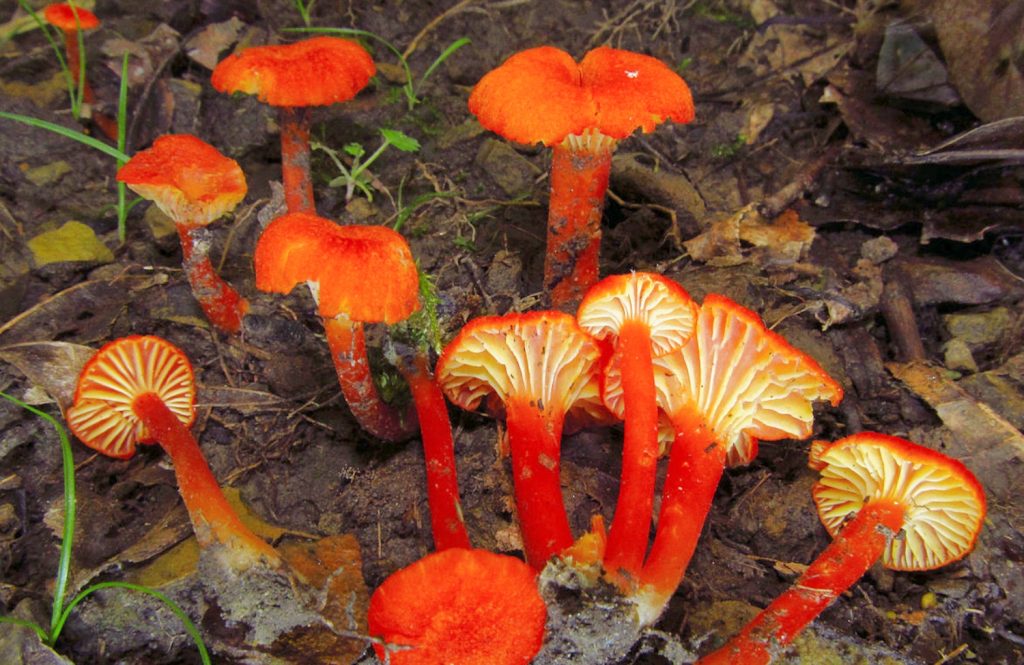
Should you get rid of the orange mushrooms growing on your lawn?
If you’ve determined that the mushrooms in your garden are toxic, then you should take measures to eradicate them. Here’s what you can do.
Remove the mushrooms by hand.
Wearing gloves, a mask, and long sleeves, place a plastic bag over the toadstool to contain the spores, then gently uproot the fruiting body and seal the bag. When you’re done, simply toss the bag in the trash.
Avoid adding mushrooms to your compost heap. As they decompose, they’ll release spores, and spreading moldy soil all over your garden is just making more problems for yourself down the road.
It’s best to remove the mushrooms in their growth cycle as early as possible, to avoid accidentally spreading any spores.
Once the mushrooms have been removed, consider applying a fungicide to prevent the mushrooms from spreading in the future.
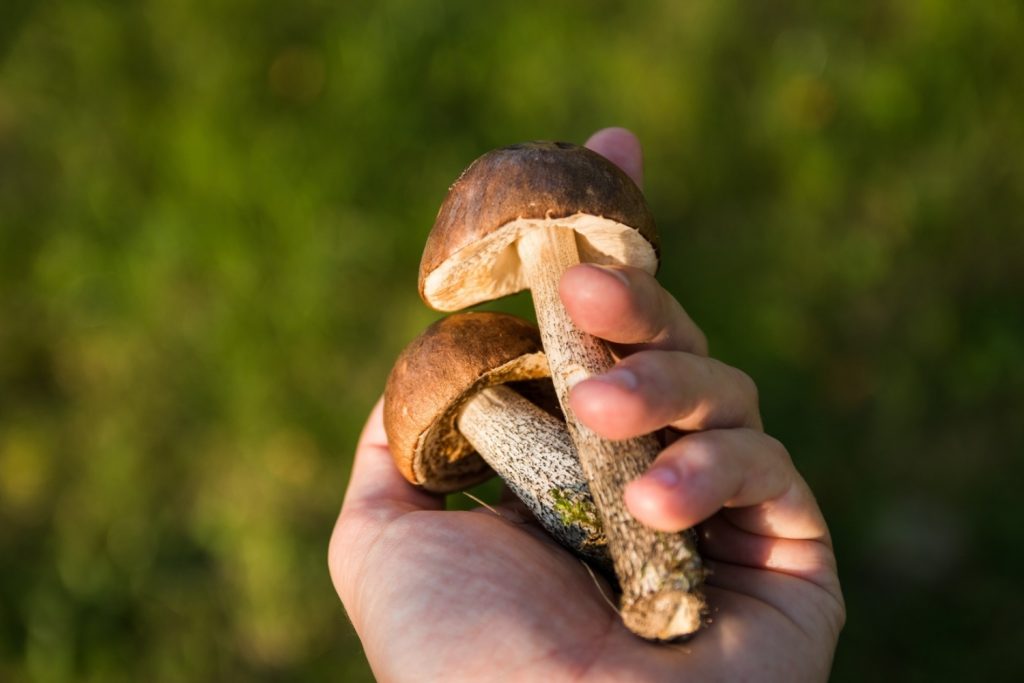
Apply baking soda
Fungi need to maintain a certain pH level in order to survive. When the pH level becomes imbalanced, this can weaken the fungi.
Sprinkle baking soda on mushrooms and all around your lawn to disrupt the pH. This discourages mycelium from producing more fruiting bodies.

Spray them with vinegar
Plain old white vinegar can also be used to alter the soil pH slightly.
Create a dilution of vinegar. Measure out 1 part vinegar and 4 parts water, then use this solution to spot-treat the mushrooms growing in your lawn or flower beds.
Only use as much vinegar water as necessary to coat the fungi. Overapplication of vinegar can be harmful to plants as well as fungi and may kill the flowers in your garden.

Make a dish soap dilution
Dish soap is a de-greaser that removes the mushroom’s outer coating making it die much more quickly.
Mix a tablespoon of dish soap with three gallons of water, and use the sudsy mixture to spray down any orange mushrooms on your lawn.
You can also poke holes in your yard near mushrooms and pour the solution into them. This will kill the mycelium responsible for producing the mushrooms.

Should you get rid of orange parasitic fungi growing on trees?
The orange fungi growing on your trees may not be a mushroom per se. But because they are parasitic, they should be dealt with immediately.
Although there is no cure for these types of fungi, you can get them to “go into remission”, and that will prolong the lives of your valuable shade trees.
It’s important to work with a professional arborist to treat infected trees.
Removing parasitized portions of the tree, replacing lost nutrients in the soil with the help of high nitrogen, high phosphorus, and high potassium fertilizers, and adding beneficial mycelium to the soil can help boost the tree’s immune system.
Taking a few small measures helps keep your trees healthy so they can ward off dangerous parasitic fungi on their own.
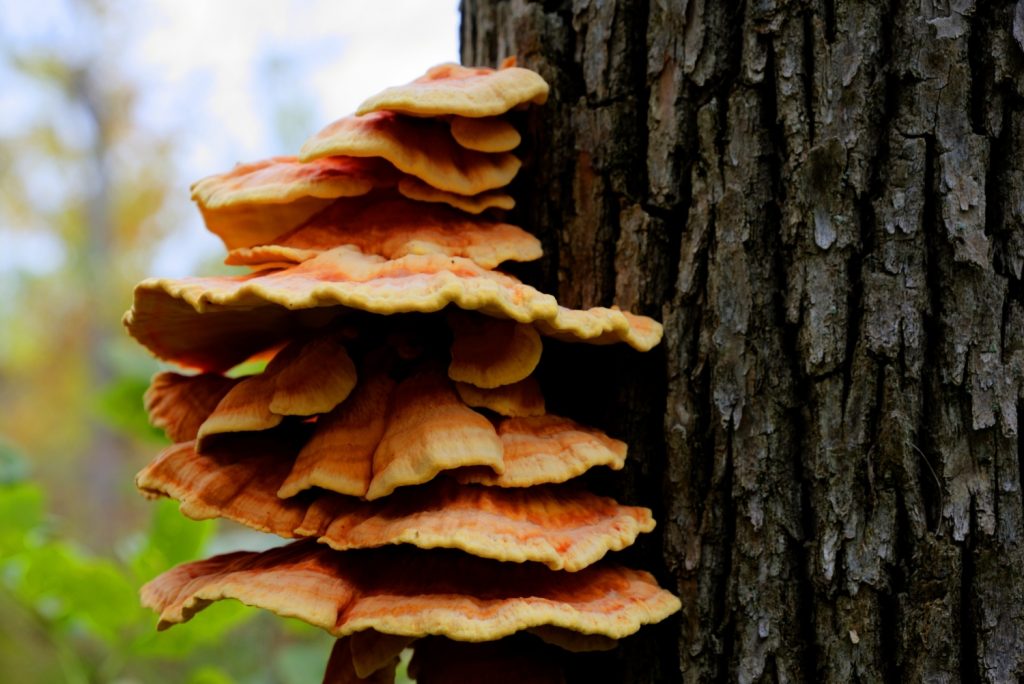
Are there any downsides to removing orange mushrooms from your lawn?
If you’ve identified the mushrooms growing in your backyard and discovered that they are non-toxic, then you really don’t need to remove them.
Mushrooms are great for your lawn and garden. They break down decaying plant matter, putting nutrients back into the soil where your flowers, fruits, veggies, and shrubs can make good use of them.
Even the mycelium of toxic mushrooms can benefit your plants.
As long as you remove toxic mushrooms so your family and pets don’t accidentally consume them, there’s no harm in allowing the mycelium to stay in the ground.
There’s no need to treat your turf with a fungicide. In fact, allowing the mycelium to remain in the soil can benefit your lawn and garden for years to come.
